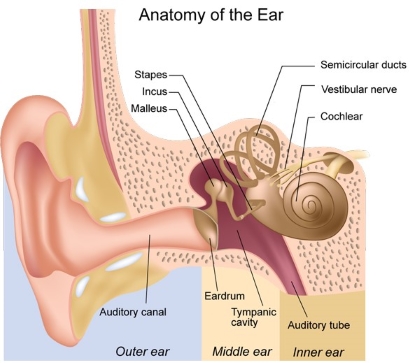The ear picks up sound waves and transforms them into electrical signals which travel along nerves to the brain. The signals are interpreted by the brain and connected to other impressions and experiences – the sound is then perceived as loud or quiet, speech, music or a message such as “the phone is ringing.”
The ear has three parts:
- Outer ear (visible part, called the “auricle” or “pinna,” and the external auditory canal)
- Middle ear (the eardrum or “tympanic membrane” and the tympanic cavity containing tiny ear bones. These are called the hammer, anvil and stirrup, or “ossicles”)
- Inner ear (cochlea and the organ of balance, called the “vestibular system”)
Sound waves reaching the outer ear cause the eardrum to vibrate. The vibrations are passed on by bones from the middle ear to the inner ear. This is where the actual organ of hearing, the cochlea, is found. The organ of balance with its three canals is also found in the inner ear.

What happens in each of the three sections of the ear?
The outer ear is made up of skin and cartilage. Like a satellite dish, it captures sound waves and passes them on to the outer ear canal. First cartilage and then further on bone help to keep this passageway open so that the sound waves can reach the eardrum without being affected.
The middle ear is an air-filled cavity also referred to as the tympanic cavity. It is connected to the upper throat by the Eustachian tube. Air moves in and out to accommodate different pressures in the outside environment. But germs can also enter the middle ear through the Eustachian tube from the upper throat.
It is the ear bones that are important for hearing: the malleus, the incus and the stapes. The malleus is attached to the eardrum, picking up its vibrations and passing them on to the inner ear via the incus and the stapes.
The sound waves are amplified by this transfer and then enter the cochlea. It is filled with fluid and lined with very fine hairs (hair cells). These cells convert the vibrations to nerve signals, which are then transported to the brain.
